Brief
Holiday sales are growing in line with expectations, although the level of promotional activity raises questions about the most important outcome: profits. In this issue, we recap November and early-December sales results, take an in-depth look at the volume of promotions and its implications, and offer ideas for infusing more profitable strategies into holiday pricing.
Moderate November growth in line with expectations
Bain estimates that the combined growth of in-store GAFS1 and e-commerce sales for November surpassed 4%, with online sales growth continuing into December at mid-double-digit rates.
- November in-store GAFS sales increased 2.4% year over year, slightly below the 2.6% growth in November last year. The greatest growth came from electronics and appliances, with a 6.9% year-over-year increase. However, consumers continued to shift their spending to non-GAFO categories: automobile dealers saw sales rise 9.5% compared to the same period last year, while sales at building materials suppliers were up 7.8% and sales at health and personal care stores grew 6.8%.
- ComScore estimates that online sales through personal computers from the beginning of November through Cyber Monday increased 16% compared to sales during the corresponding shopping period last year. Green Monday, which typically falls on the second Monday in December, broke records this year, reaching $1.6 billion in online spending, up 15% over last year, and making it the third heaviest online-spending day of the season so far.
- Sales through mobile devices, including smartphones and tablets, were especially strong over Thanksgiving, Black Friday and Cyber Monday, accounting for at least 20% of online sales on each of those days.
Unwrapping holiday pricing traditions
We expect that as demand rises, so do prices and profit margins. Unfortunately, this is no longer true for the average retailer in the holiday season. Even as demand recovers from the Great Recession, the volume of holiday promotions (volume = depth × breadth × length) continues to grow, while operating margins shrink. A number of factors are at work here:
- Deeper promotions. Doorbuster deals are again in full swing this holiday season. Discounts of more than 50% on Black Friday, for example, brought TV prices to record lows; and discounts on toys reached 75% on Cyber Monday. In collaboration with 360pi, we assessed daily online price changes over the first half of the holiday shopping season.2 Looking at prices from November 1 to December 2, we found that, on average, discounts have been deeper this year than last. In electronics and computers, more than half of retailers offered even lower prices this year compared to last year’s deeply discounted prices; and in toys and games, one retailer dropped its average price by more than 2.5 times its average discount last year.
- Broader promotions. Retailers are continuing to discount broad assortments of goods this year, with storewide discounts being used aggressively. Bain worked with SaleTally to examine the extent to which retailers offered storewide discounts this November.3 Over half of the 17 retailers analyzed ran storewide promotions this year, indicating a significant breadth in discounted assortment. Average storewide discounts were over 35%, 5 percentage points deeper this year compared to last year.
- Longer promotions. With retailers offering Black Friday discounts even earlier this year (see Bain’s "Retail Holiday Newsletter #3: The sprint toward Christmas"), promotions are running longer. Data from 360pi on daily online price changes show that some retailers had started promotions in electronics and computers by November 1 and ran discounts for more consecutive days than last year. Retailers also extended Cyber Monday promotions: Bloomingdale’s, JCPenney and others launched online discounts the week before Cyber Monday and continued the deals through the following week.
- More frequent price changes. Dynamic online pricing has exacerbated holiday pricing madness. Our partnership with 360pi looked at the frequency of price changes by examining the percentage of products that changed price from the prior day, for a sample of 5,000 SKUs. In November, Amazon.com changed its prices on an average of 20% of products in the assortment, more than any other retailer. This holiday season, more retailers are responding in kind. Office Depot, for example, changed prices on 30% of its products on the Saturday after Thanksgiving; that rate was just 18% on any single day last year. Price differentials are moving more closely in sync with Amazon.com this year as more retailers resolve to keep pace with the online giant’s price changes.
- Greater price messaging. In addition to deeper, broader, longer and more frequent discounts, retailers are broadcasting their promotions more loudly. Bain’s proprietary research with Quad Analytix found that the total number of promotional e-mails increased by 45% in the first two weeks of November compared to last year, and by 69% the week before Thanksgiving.4
The result of this multiyear trend is that fourth-quarter operating margins are no longer significantly better than margins the rest of the year. Historically, holiday margins held a 2-point advantage over margins earned in other quarters. Since 2010, however, fourth-quarter operating margins for 16 of the largest US retailers fell 190 basis points on a weighted average basis. Today, margins during the busiest season are nearly identical to those during the rest of the year (see Figure 1).
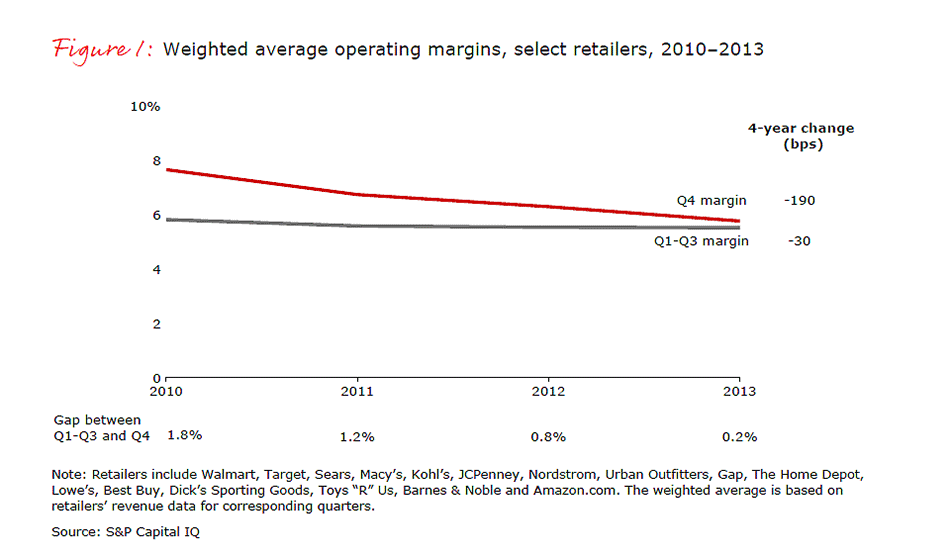
How did this happen to the most wonderful time of year? The answer is simple: Promotions are addictive—to both customers and retailers. Inundated by deals during the Great Recession, customers have developed an aversion to paying full price and a craving for larger and larger discounts. For their part, retailers have grown accustomed to the boost in volume promotions generate, and they are hesitant to cut promotions for fear that revenues will crater.
Bain recently conducted a survey with PollBuzzer of 1,000 US adults to determine just how pervasive consumers’ addiction to discounts has become:5
- Two-thirds of the consumers we spoke with say that they are looking harder to find deals this year than they did last year.
- Over half report that early deals encouraged them to start shopping sooner this year.
- Just two weeks before Christmas, more than three-quarters still had holiday shopping to do; and of those consumers, close to three-fifths say they are waiting for prices to drop further before finishing their holiday shopping.
Interestingly, these behaviors don’t vary substantially based on income level, or changes in personal financial position. Three-quarters of all respondents indicate that they “get a thrill from finding the best deals during the holiday,” suggesting that it’s more about emotions than economics. More shoppers are becoming emotionally dependent on deals, and more deals are required to deliver the same shopping “highs”.
Applying strategy to cut through the promotional frenzy
If strategy is defined as concentrating one’s unique strengths against competitors’ weaknesses at critical decision points, it’s hard to see how shifting resources from differentiated value propositions for 10 months of the year to undifferentiated promotions during the holiday season makes strategic sense. We recognize the role of promotions in holiday shopping, but the key is to captivate, not confuse, customers. Excessive holiday promotions are bad strategy for four reasons:
- Funding greater discounts pulls resources from other important elements of the customer’s experience. Research from Ebiquity suggests that 33% of customers would pay 5% more for excellent service, 25% would pay 10% more and about 15% would pay 20% more.
- Loyal customers will notice the erosion of the experience they once loved, lose trust in the brand and grow more sensitive to price.
- Most of the new customers that come for low prices will leave when those deals go away.
- Discounts and promotions are the easiest part of a value proposition to copy, so competitors tend to push them until everyone runs out of profits.
It is possible to strengthen strategy through the promotional frenzy of the holidays. Bain’s research has identified three major imperatives:
- Shift the focus of deals from incremental product sales to lifetime customer value. Incremental sales driven by holiday promotions are tempting but not always worth the investment. During the holidays, half of shoppers leave their preferred retailers to buy wherever they get the best price. But customers who are attracted by deals are also the first to defect for better deals elsewhere. About 60% of shoppers in our PollBuzzer survey said that after chasing last year’s holiday deals, they returned to shopping as usual at their preferred retailers. An additional 8% said that they actually increased spending at their preferred retailers after being disappointed with their experiences in stores that offered big holiday discounts.
We partnered with DataSong to analyze the value of new customers acquired during the holidays.6 By measuring customer spending in the 12 months following acquisition, we found that customers acquired during the holidays typically spend only 61% as much as customers acquired during the rest of the year (see Figure 2).
The question we need to ask: Are our promotional strategies attracting customers who are most adroit at couponing or those who most prize our fundamental value proposition? Every retailer wants to capitalize on hot holiday gifts—from Cabbage Patch Kids to Elsa dolls to the latest Xbox—but heavily promoting products in categories they are neither known for nor strong in does little more than drive one-time traffic. To acquire new customers with the potential to be future loyalists, retailers have to design smart offers that find and attract the right targets.
Many retailers have tools like rewards programs and customized coupons that can direct deals toward more valuable and more loyal customers. For example, the holidays can be a great time to encourage shoppers to redeem rewards by increasing the value of those rewards. Marketing research has found that a customer’s decision to redeem a reward can lead him or her to purchase more frequently and to spend more. As an added benefit, this approach feels fair to almost all customers: Only 16% of shoppers we surveyed don’t agree that the best customers should get the best deals. Other promotional tactics such as bounce-back discounts for future purchases, tiered promotions based on spend levels and conditional deals triggered by basket size help increase customer value and return on investment.
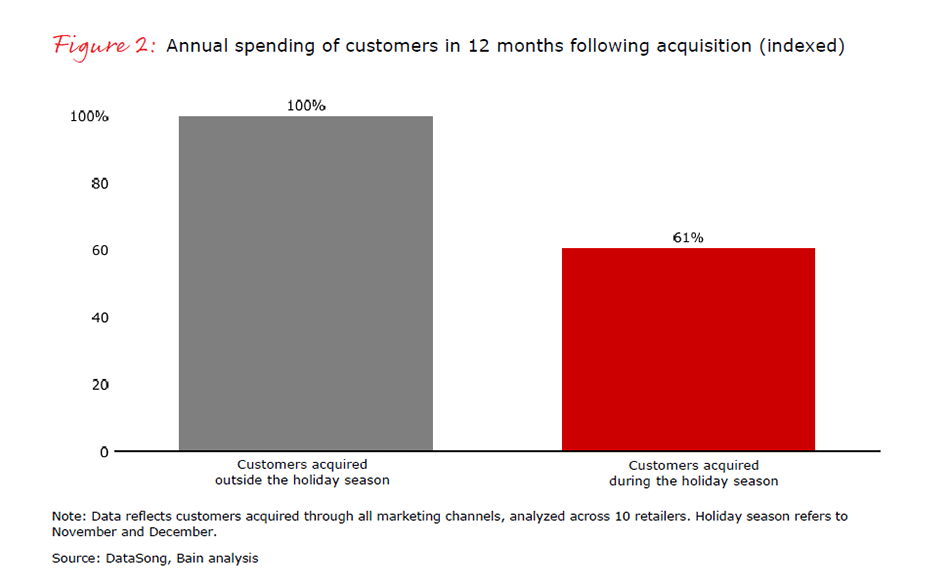
- Invest in sources of value beyond deals. The most successful and profitable holiday promotions are ones that generate benefits beyond savings. For most retailers, beating the competition soundly on unique merchandise, more emotionally engaging offers or a better in-store experience while staying competitive on price will produce longer-lasting results than beating the competition soundly on price but being below par on everything else. Shoppers are exhilarated by good deals. But desirable product offerings, surprising service, convenience and the emotional fulfillment of helping others can also generate positive reactions, and more enduring results.
This is especially true with millennials, who shop with a mindset of pragmatic idealism. Millennials are price-conscious; but because they are confident that technology can help them find good deals, they also are looking to satisfy higher-level needs. They expect a convenient and personalized shopping experience. They want to choose from curated options that differentiate not only on price, but also on emotional and experiential value.
Promotions should draw shoppers’ attention, but other elements of the customer’s experience (especially those elements that have proved most important to a retailer’s best customers) must also be showcased. Bain’s research has identified 23 elements of value that lift products and services above commodity status. They range from functional benefits—reducing effort or saving time, for example—to more emotional benefits, including anxiety reduction, affiliation, self-actualization and fun. These are what will hook holiday shoppers on the brand experience and keep them coming back for many years to come. - Plan with economics and execution in mind. Bain research shows that pricing can impact profits more than any other business lever. A 1% increase in realized prices typically has twice the impact on profits as does share gain, reducing the cost of goods or even labor savings. Price promotions are important—especially during the holidays—but maximizing the return on these investments is a delicate balance that warrants rigorous analysis of offer economics. One area where many retailers trip up: deciphering the true impact of money-losing promotions. Although some of these offers may draw customers to stores and anchor bigger baskets, a greater number will fail to generate the promised full-store lift. For example, a basket containing two promoted items means there are two buyers in the organization that might claim credit for that basket based on the promotions in their categories. More retailers are adding dedicated analysts to assess whether such economic “halo” effects are real and, if so, to ensure they are counted only once. They also explore innovative strategies for putting vendor-funded promotional dollars to their highest and best use.
Even the best-laid and well-tested promotional plans fail if the customer’s experience suffers or the customer’s trust is broken. The holiday season offers retailers the greatest opportunity to impress potential customers. However, it’s also the hardest time of the year to get things right. More than 65% of holiday shoppers we surveyed mentioned long lines in stores as one of their top-three frustrations; about 40% mentioned stockouts; and 25% cited unhelpful salespeople. Sales associates grappling with complicated promotional policies, websites crashing as volumes spike, and online prices bouncing around hourly or varying across devices or channels all generate customer frustration and lost sales. Ensuring promotions are easy for employees to execute, creating a seamless experience across channels and using special offers to shift traffic to off-peak windows can significantly improve customer experiences.
Trust is an essential ingredient in building loyal customer relationships. While customers love the thrill of a deal, they don’t like feeling fooled. Of the holiday shoppers we surveyed, 73% feel cheated when they buy something and then see the price drop further, and 65% feel cheated when they see other customers getting better deals. Price-matching policies can help, but they can also create even more frustration as customers and sales associates decode the complexities of various programs. Perhaps rather than trying to turn loyal customers into day traders or investigative researchers, retailers would do better by developing innovative ways to increase consumer confidence and basket sizes. Just to be provocative, what if in October a retailer were to offer its best customers automatic price matching for the holiday season (to be given in the form of a year-end coupon for future usage) if they spend at least $XXX (based on last year’s spending)? Each week they might receive an update on how close they are, how much they've saved, and maybe even customized gifts or free samples. For those customers that beat their goal, they may receive additional incentives to further increase spending. And the process of building trust-based relationships doesn’t end at Christmas. Bain’s research shows that convenient returns are one of the most important contributors to customers’ overall satisfaction.
As the 2014 holiday season comes to a close, now is the time to prepare for the 2015 holidays. A careful post-holiday audit ensures an even better season in 2015 and beyond (see Figure 3).
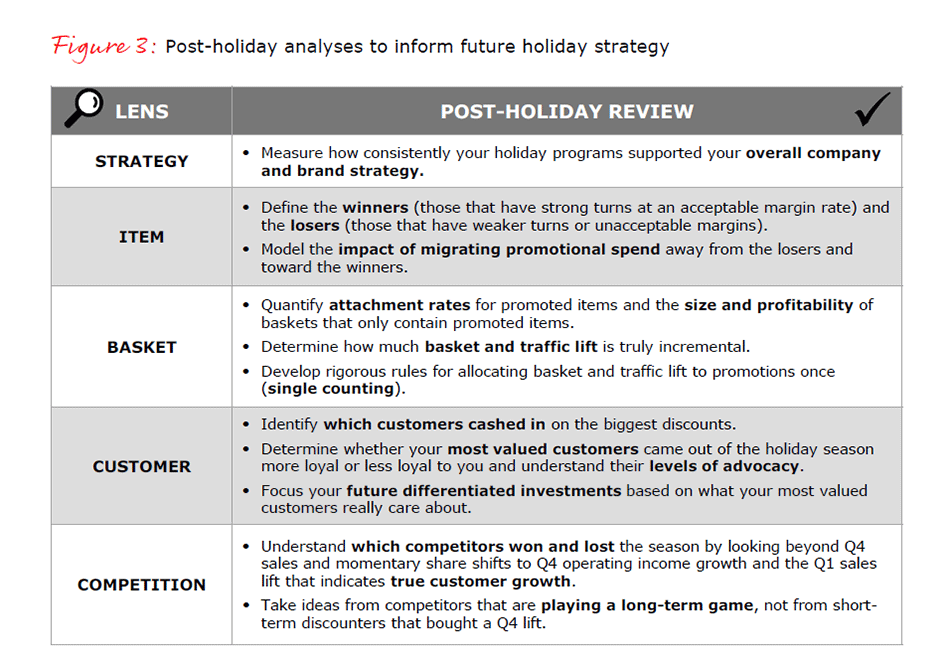
What’s in store for next year?
Our next and final newsletter, released at the end of January, will recap holiday season sales and examine how leading companies are applying next generation solutions to improve customers’ experience and accelerate profitable growth. We wish you success in the final week before Christmas and look forward to connecting with you in the new year. Happy holidays!
Appendix
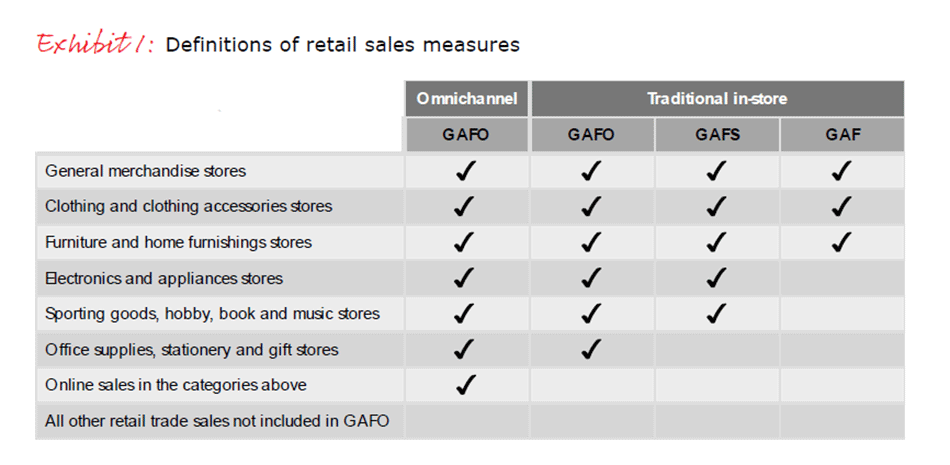
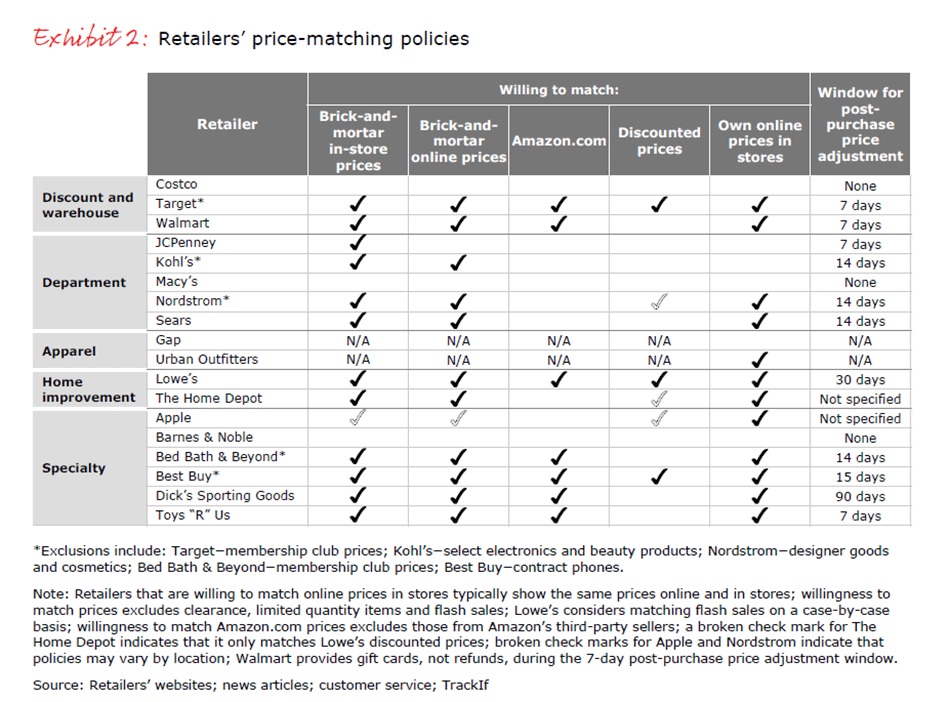
For a list of selected references, please view the full PDF
1 GAFS sales are an advance estimate of GAFO sales. They include sales at general merchandise stores; clothing and clothing accessories stores; furniture and home furnishings stores; electronics and appliances stores; and sporting goods, hobby, book and music stores. See Exhibit 1 in the Appendix for definitions of GAFS and other sales measures.
2 A pricing analytics company, 360pi (www.360pi.com) helps retailers and brands make smarter pricing decisions. According to the company, it works with top retailers to enable them to “gain real-time visibility into the market, full awareness of the competitive pricing landscape and the ability to ‘right-price’ to shoppers, which often leads to revenue uplift and higher margins.” For this newsletter, the company tracked pricing across five categories and seven retailers.
3 SaleTally (www.saletally.com) is a retail data and analytics service that tracks marketing information from about 200 nationwide retailers. SaleTally recently became a part of ShopperTrak, a global provider of location-based analytics. According to the company, combining SaleTally’s promotion data with ShopperTrak’s robust data platform will enable new marketing-effectiveness tools for the retail industry. For this newsletter, Bain partnered with SaleTally to track storewide in-store and online discounts at eight apparel players, six department stores and three specialty retailers.
4 Quad Analytix (www.quadanalytix.com) provides retailers with market intelligence to inform their business decisions. According to the company, it captures and analyzes product, pricing, placement and promotion data from hundreds of retailers and presents the information in an easy-to-use software as a service (SaaS) application. For this newsletter, Quad Analytix tracked promotional e mails from more than 70 retailers across a range of sectors.
5 PollBuzzer™ (www.askpollbuzzer.com), a provider of real-time surveys, has expanded its capabilities by partnering with market research industry leader ROI Rocket to provide full-service solutions to management consulting, private equity, hedge fund, retail and consumer products clients. According to PollBuzzer, the combination of the latest survey and panel verification technologies and the industry’s widest and deepest pools of potential respondents enable PollBuzzer & ROI Rocket to complete quantitative and qualitative projects globally.
6 DataSong (www.datasong.com), a software as a service (SaaS) provider, offers multichannel attribution to leading retailers. According to the company, its marketing effectiveness solutions help leading retail organizations measure, plan and act on customers’ insights to grow their business.




